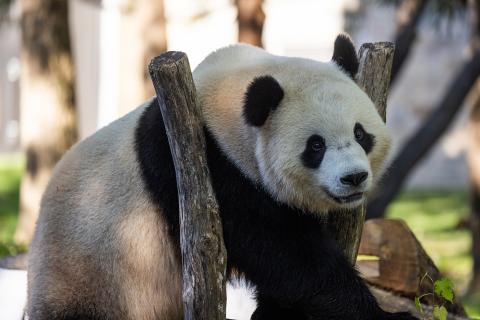Giant pandas are native to central China and have come to symbolize vulnerable species. As few as 1,864 giant pandas live in their native habitat, while another 600 pandas live in zoos and breeding centers around the world.
Physical Description
The giant panda, a black-and-white bear, has a body typical of bears. It has black fur on its ears, eye patches, muzzle, legs, and shoulders. The rest of the animal's coat is white. Although scientists do not know why these unusual bears are black and white, some speculate that the bold coloring provides effective camouflage. In patches of dense bamboo, an immobile giant panda is nearly invisible, and virtually disappears among snow covered rocky outcrops on a mountain slope. This theory does not work, however, when considering that giant pandas have no natural enemies to hide from. Another thought is that the pattern may accentuate social signals in some way, or help giant pandas to identify one another from a distance so they can avoid socializing, as they are typically a solitary animal. Another theory suggests that the black absorbs heat while the white reflects it, helping giant pandas maintain an even temperature. Unfortunately, there is no one conclusive theory as to why giant pandas are black and white.
The giant panda has lived in bamboo forests for several million years. It is a highly specialized animal, with unique adaptations. The panda's thick, wooly coat keeps it warm in the cool forests of its habitat. Giant pandas have large molar teeth and strong jaw muscles for crushing tough bamboo. Many people find these chunky, lumbering animals to be cute, but giant pandas can be as dangerous as any other bear.
Size
About the size of an American black bear, giant pandas stand between 2 and 3 feet (60 to 90 centimeters) tall at the shoulder (on all four legs), and reach 4 to 6 feet (1.2 to 1.8 meters) long. Males are larger than females, weighing up to 250 pounds (113 kilograms) in the wild. Females rarely reach 220 pounds (104 kilograms).
Native Habitat
Giant pandas live in a few mountain ranges in south central China, in Sichuan, Shaanxi and Gansu provinces. They once lived in lowland areas, but farming, forest clearing and other development now restrict giant pandas to the mountains.
Giant pandas live in broadleaf and coniferous forests with a dense understory of bamboo, at elevations between 5,000 and 10,000 feet. Torrential rains or dense mist throughout the year characterizes these forests, often shrouded in heavy clouds.
Lifespan
Scientists are not sure how long giant pandas live in the wild, but they are sure it is shorter than lifespans in zoos. They estimate that lifespan is about 15-20 years for wild pandas and about 30 years for those in human care. Chinese scientists have reported zoo pandas as old as 35. The Smithsonian National Zoo's Hsing-Hsing died at age 28 in 1999.
Communication
Giant pandas do not exhibit body characteristics that communicate visual signals. They have round, inexpressive faces. Their tails are stubs and therefore cannot flag signals to other giant pandas. They have no crest or mane to erect, and their ears are not flexible enough to cock forward or flatten. It is thought that giant pandas never developed these visual accessories due in part to their habitat and solitary nature. Giant pandas live in dense, fog-enshrouded stands of bamboo that obstruct a direct line of sight and any potential visual communications. Giant pandas do occasionally vocalize when playing. During mating, they become very vocal, relying on extremely detailed vocalizations to express all shades of mood from amorous to angry.
Most of their communication is accomplished through scent marking throughout their habitat and territory. Giant pandas mark their territory by rubbing secretions from their anal glands onto tree trunks, rocks or the ground, usually along paths that they habitually tread. Scent marking alerts giant pandas in the vicinity to one another. Depending on who reads the mark, the scents may either separate giant pandas or help bring them together. Outside of breeding season, a scent mark that is unfamiliar is usually enough to send a potential intruder ambling away. During breeding season, however, a female's scent mark advertises her sexual readiness and draws males to her. A female is more likely to accept a male whose scent she recognizes and has encountered before.
Food/Eating Habits
Millions of Zoo visitors enjoy watching giant pandas eat. A panda usually eats while sitting upright, in a pose that resembles how humans sit on the floor. This posture leaves the front paws free to grasp bamboo stems with the help of a "pseudo thumb," formed by an elongated and enlarged wrist bone covered with a fleshy pad of skin. The panda also uses its powerful jaws and strong teeth to crush the tough, fibrous bamboo into bits.
A giant panda's digestive system is more similar to that of a carnivore than an herbivore, and so much of what is eaten is passed as waste. To make up for the inefficient digestion, a panda needs to consume a comparatively large amount of food—from 70 to 100 pounds of bamboo each day—to get all its nutrients. To obtain this much food means that a panda must spend 10 to 16 hours a day foraging and eating. The rest of its time is spent mostly sleeping and resting.
Sleep Habits
In the wild, giant pandas typically nap between feedings for two to four hours at a time, snoozing on their side, back, or belly, either sprawled or curled up. While a giant panda is resting, it continues to defecate. The number of droppings at a rest site can be used to gauge the relative amount of time a giant panda spent at that site. During a short rest of less than two hours, there are five to ten droppings. Eleven to 25 droppings often accompany rests lasting longer than two hours. Most rest periods are two to four hours in duration but may increase to six or more hours during the summer months.
Social Structure
Adult giant pandas may be generally solitary, but they do communicate periodically through scent marks, calls and occasional meetings. Recent research has also found that giant pandas may form communities of seven to 15 individuals within the local population.
These individuals occupy a "group" territory, within which male home ranges overlap almost completely, while female home ranges overlap far less. Members of different "groups" generally avoid socializing with each other. Offspring stay with their mothers from one and a half to three years.
Reproduction and Development
Giant pandas reach breeding maturity between 4 and 7 years of age. They may be reproductive into their 20s. Female pandas ovulate only once a year, in the spring. A short period of two to three days around ovulation is the only time a giant panda is able to conceive. Calls and scents draw males and females to each other.
Female giant pandas give birth from 90 to 180 days after mating. Although females may give birth to two young, usually only one survives. Giant panda cubs may stay with their mothers for up to three years before striking out on their own. This means that a wild female, at best, can produce young only every other year. In a lifetime, a giant panda may successfully raise only five to eight cubs.
The giant pandas' naturally slow breeding rate prevents a population from recovering quickly from illegal hunting, habitat loss and other human-related causes of mortality. At birth, a giant panda cub is helpless, and it takes considerable effort on the mother's part to raise it. A newborn cub weighs 3-5 ounces and is about the size of a stick of butter. Pink, hairless, and blind, the cub is 1/900th the size of its mother. Except for a marsupial, such as a kangaroo or opossum, a giant panda baby is the smallest mammal newborn relative to its mother's size.
Cubs do not open their eyes until they are 6-8 weeks old and are not mobile until they are 3 months old. A cub may nurse for eight to nine months and is nutritionally weaned at 1 year old, but not socially weaned for up to two years.


